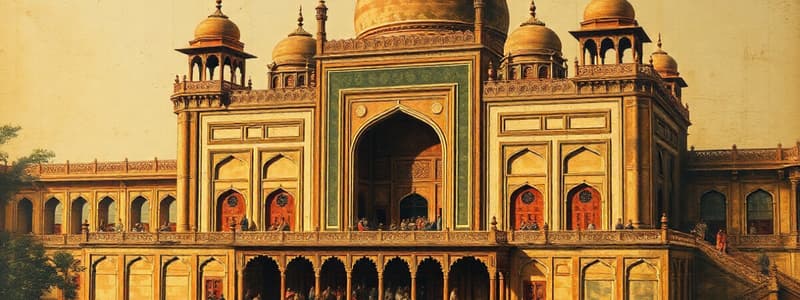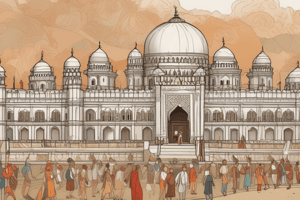Podcast
Questions and Answers
Who founded the Mughal Empire by defeating Ibrahim Lodi in 1526?
Who founded the Mughal Empire by defeating Ibrahim Lodi in 1526?
- Aurangzeb
- Shah Jahan
- Babur (correct)
- Akbar
The Mughal Empire was dissolved in the early 17th century.
The Mughal Empire was dissolved in the early 17th century.
False (B)
Which Mughal emperor is known for his religious intolerance and heavy taxation?
Which Mughal emperor is known for his religious intolerance and heavy taxation?
- Jahangir
- Shah Jahan
- Aurangzeb (correct)
- Akbar
Which Mughal emperor is known for commissioning the Taj Mahal?
Which Mughal emperor is known for commissioning the Taj Mahal?
_________ captured Delhi back in 1555.
_________ captured Delhi back in 1555.
Match the Mughal emperors with their notable achievements:
Match the Mughal emperors with their notable achievements:
Which policy is Akbar most known for?
Which policy is Akbar most known for?
The Mughal Empire’s economy primarily depended on manufacturing.
The Mughal Empire’s economy primarily depended on manufacturing.
Which architectural marvels exemplify Mughal architectural achievements?
Which architectural marvels exemplify Mughal architectural achievements?
What language is considered a blend of Persian and local languages, influenced by the Mughal Empire?
What language is considered a blend of Persian and local languages, influenced by the Mughal Empire?
Akbar’s policy of __________ promoted peace among all religions.
Akbar’s policy of __________ promoted peace among all religions.
Match the following battles with the emperors associated with them:
Match the following battles with the emperors associated with them:
After which Mughal emperor's death did the empire begin to decline?
After which Mughal emperor's death did the empire begin to decline?
The invasion by Nadir Shah had minimal impact on the Mughal Empire.
The invasion by Nadir Shah had minimal impact on the Mughal Empire.
Name one way the British East India Company affected the Mughal Empire.
Name one way the British East India Company affected the Mughal Empire.
________ quickly gained ascendency over her husband.
________ quickly gained ascendency over her husband.
Match the term to remember with the definition.
Match the term to remember with the definition.
Which regions did the Mughal Empire encompass at its peak?
Which regions did the Mughal Empire encompass at its peak?
Akbar became the Mughal Emperor at the age of 25.
Akbar became the Mughal Emperor at the age of 25.
Which aspect of Indian culture did the Mughal Empire NOT significantly influence?
Which aspect of Indian culture did the Mughal Empire NOT significantly influence?
Flashcards
Mughal Empire: Geography
Mughal Empire: Geography
Established in 1526, dissolved mid-18th century, encompassing India, Pakistan, Bangladesh, and Afghanistan.
Babur
Babur
Founder of the Mughal Empire, descendant of Timur and Genghis Khan.
Akbar's Legacy
Akbar's Legacy
Known for religious tolerance, administrative reforms, and cultural integration during his reign from 1556-1605.
Shah Jahan
Shah Jahan
Signup and view all the flashcards
Aurangzeb
Aurangzeb
Signup and view all the flashcards
Babur's military win
Babur's military win
Signup and view all the flashcards
Humayun's recapture
Humayun's recapture
Signup and view all the flashcards
Sulh-i-Kul
Sulh-i-Kul
Signup and view all the flashcards
Subahs
Subahs
Signup and view all the flashcards
Aurangzeb's death
Aurangzeb's death
Signup and view all the flashcards
Cultural Synthesis
Cultural Synthesis
Signup and view all the flashcards
Nur Jahan's Influence
Nur Jahan's Influence
Signup and view all the flashcards
Mughal Legacy
Mughal Legacy
Signup and view all the flashcards
Study Notes
- The Mughal Empire is an overview of its rise, culture, and legacy
- The Mughal Empire existed in South Asia
Key Terms
- Genealogy is a term for remembering
- Mansabdar is a term for remembering
- Zat is a term for remembering
- Jagir is a term for remembering
- Zabt is a term for remembering
- Diwan is a term for remembering
Mughal Empire Classical Period
- Babur reigned 1526-1530
- Humayun reigned 1530-1556
- Akbar reigned 1556-1605
- Jahangir reigned 1605-1627
- Shah Jahan reigned 1628-1658
- Aurangzeb reigned 1659-1707
Duration and Geography
- The Mughal Empire was established in 1526
- The Mughal Empire dissolved in the mid-18th century, officially after the British took control in the 1850s
- It geographically encompassed large parts of present-day India, Pakistan, Bangladesh, and parts of Afghanistan
Founding and Major Figures
- Babur, a descendant of Timur and Genghis Khan, founded the empire
- He defeated Ibrahim Lodi at the First Battle of Panipat in 1526
Notable Emperors
- Humayun experienced a significant fall but returned to power with Persian assistance
- Akbar (1556-1605) is known for policies of religious tolerance, administrative reforms, and cultural integration
- Akbar is often regarded as one of the greatest emperors
- Shah Jahan (1628-1658) is famous for architectural contributions, notably the Taj Mahal, built in memory of Mumtaz Mahal
- Aurangzeb (1658-1707) oversaw the empire's greatest territorial extent but faced criticisms for religious intolerance and heavy taxation
Military Campaigns
- Babur, the first Mughal emperor, captured Delhi in 1526 by defeating Ibrahim Lodi in the Battle of Panipat
- Humayun captured Delhi back in 1555
- Akbar captured Chittor (1568), Ranthambor (1569), Gujarat, Bihar, Bengal, Kashmir, Berar Khandesh, etc. (1585-1605)
- Jahangir campaigned against Sikhs and Ahoms
- Shah Jahan captured Ahmadnagar and Bijapur
- Aurangzeb waged a long battle in the Deccan
Akbar’s Policies
- Akbar ardently desired religious unity in India, and therefore founded a religion
- Akbar held discussions with the Brahmin scholars, and reputed theologians of other faiths in the balcony of his room during the night
- The emperor adopted many Hindu beliefs and practices
- Spiritual awakening changed Akbar's religious policy
Nur Jahan
- Nur Jahan quickly gained ascendency over her husband
- She was one of the most powerful and influential women at court during the Mughal Empire
- She was more decisive and proactive than her husband
Timeline
- 1237: Genghis Khan died
- 1404: Timur died
- 1526-1530: Reign of Babur
- Babur captured Delhi in 1526, defeating Ibrahim Lodi and establishing the Mughal Empire
- 1539: Sher Shah defeated Humayun at Chausa
- 1540: Sher Shah defeated Humayun at Kanauj
- 1555: Humayun recaptured Delhi
- 1556: Akbar became the Mughal Emperor at the age of 13
- 1568: Akbar seized Sisodiya capital of Chittor
- 1569: Akbar seized Ranthambhore
- 1605-1627: Jahangir ruled over Delhi as the Mughal emperor
- 1627-1658: Shah Jahan reigned over Delhi
- 1632: Ahmednagar annexed by Shah Jahan
- 1658-1707: Aurangzeb reigned over Delhi
- 1685: Aurangzeb annexed Bijapur
- 1687: Aurangzeb annexed Golconda
- 1698: Aurangzeb campaigned in the Deccan against the Marathas
Administration and Economy
- The Mughal Empire developed a strong centralized administration with a complex bureaucracy
- This utilized a system of provinces (subahs) governed by appointed officials
- The economy thrived on agriculture, trade, and a rich craft industry, leading to a prosperous society and the emergence of urban centers
- There was a centralized bureaucracy, with ministers and noble classes playing key roles
- A taxation system and land revenue policies were implemented
- Regional governance consisted of semi-autonomous provinces
Cultural Contributions
- The Mughal Empire made significant contributions to art, architecture, and literature, merging Persian, Indian, and Islamic influences
- Architectural marvels like the Taj Mahal, Red Fort, and Fatehpur Sikri exemplify Mughal achievements
- Persian influence can be seen in Indian art and language, with Urdu being a blend of Persian and local languages
- Akbar's policy of Sulh-i-Kul promoted peace among all
- There was a promotion of religious syncretism with Din-i Ilahi
- Tensions during Aurangzeb's rule impacted Hindu-Muslim relations
Economic Development
- Prosperity came through agriculture, trade, and commerce
- Trade routes connecting India with Europe and Central Asia played an important role
- There was urbanization and growth of cities
Decline
- The empire declined after the death of Aurangzeb, due to internal strife, succession disputes, and rising regional powers
- The invasion by Nadir Shah of Persia in 1739 and the rise of the British East India Company caused disintegration
Legacy
- The Mughal Empire left a lasting cultural and historical impact on the Indian subcontinent
- It influenced architecture, language, cuisine, and regional governance structures
- Complex history continues to shape the modern identity and socio-political landscape of South Asia
Studying That Suits You
Use AI to generate personalized quizzes and flashcards to suit your learning preferences.




